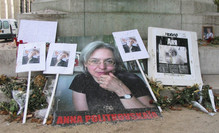 Tributes to Anna Politkovskaya Credit: Tej
Tributes to Anna Politkovskaya Credit: Tej Women media professionals from several east European nations are more likely to shatter the glass ceiling than their counterparts in the rest of the world, according to a new study on gender equality in the news business.
The presence of women at nearly all levels, from the newsroom to the boardroom, is attributed to the legacy of communist-era egalitarianism and modern policies on equal rights in new European Union states that were once behind the Iron Curtain.
Globally, the International Women’s Media Foundation (IWMF) study shows that nearly two-thirds of media employees are men and the imbalance grows at the top: 73 per cent of publishers, chief executives and other senior posts are occupied by men, while males comprise 64 per cent of reporting jobs. The analysis covered 522 companies in 59 countries.
The Washington-based organisation's research director says the study is one of the more comprehensive of its kind. Elisa Lees Munoz says the 396-page report shows that there is no shortage of work to be done to close the gender gap.
"Women are underrepresented in the news media, and while we don't have any proof that that is a serious issue for society, it is a serious issue for women who want to be in this line of work," Munoz said in a telephone interview. "We need to do something about that and make a more even playing field."
Communist-era egalitarianism
The Global Report on the Status of Women in the News Media shows that Russia and seven East European nations are global leaders in gender equality.
"There really was a more even playing field under communism and the numbers that we see are a residual of those policies," Munoz says.
There is also a more practical reason. As communist-era institutions and state firms collapsed, cracks in communist-era egalitarianism began to show.
"Women lost jobs first, and those women were looking for new opportunities," says Diana Nastasia, a former media lecturer in Romania who was the Eastern Europe coordinator for the IWMF study.
"They were there first and they were there in higher numbers."
Besides Russia, the report groups together Ukraine and EU members Bulgaria, Estonia, Hungary, Lithuania, Poland and Romania. Women in these countries played a central role in building independent media as the Soviet Union and its east-bloc allies unraveled, and females remain prominent journalists and media-rights advocates.
Several women media professionals in Russia have paid a bloody price for their work.
Women and men are in close parity at nearly all of the 31 newspapers, 27 television stations and 27 radio stations that participated in the IWMF survey in the eight nations. The survey also showed little wage distinction between female and males workers.
The study breaks the world into seven regions. The findings show that in Eastern Europe:
- Women hold 59.9 percent of reporting jobs and other junior-level positions, compared to the global average of 36.1 percent.
- Females comprise 49.8 percent of middle-management posts, such as editors, design directors and chief correspondents, compared to 28.7 percent globally.
- Women make up 40.9 percent of those in senior newsroom management, 43.4 percent of those in top-level business management (publishers and chief executives), and 32.9 percent of those in holding positions on corporate boards or other governing roles. Globally, the figures are 38.7 percent, 27.3 percent and 25.9 percent respectively.
- Women’s participation is highest (69.4 percent) in the support roles associated with sales, finance and administration, compared to 35.6 percent globally, while across the board, females are least likely to hold technical and creative jobs.
Though positive about the region's relative gender parity, the IWMF report shows significant pay disparities in Ukraine, where some men earn as much as 14 times more than women in a comparable job.
While shedding light on the status of women in the media, the IWMF report does little to address the daunting challenges faced by journalists regardless of gender, especially in Russia.
Media freedom and editorial independence have all but disappeared since the 1990s, and at one crusading Moscow newspaper, Novaya Gazeta, five correspondents and a staff lawyer have been slain since 2000. Three of the correspondents were females – Anna Politkovskaya (tributes pictured above), Anastasia Baburova and Natalya Estemirova.
IWMF's Nastasia acknowledges that while the study did not directly address media freedoms, her researchers encountered brick walls in Russia. "We had to knock on very many doors to obtain as much as we did, whereas in the other countries of the region, we had relatively open access."
"It would be interesting to consider how men versus women would differently approach the ways in which the system has been closing rather than opening," says Nastasia, who holds a doctorate in communications from the University of North Dakota in the United States.
The IWMF research was conducted over a two-year period using a mix of surveys and direct interviews. The study was released just before World Press Freedom Day on 3 May.
Image by the Tej on Wikimedia Commons. Some rights reserved.
Free daily newsletter
If you like our news and feature articles, you can sign up to receive our free daily (Mon-Fri) email newsletter (mobile friendly).









